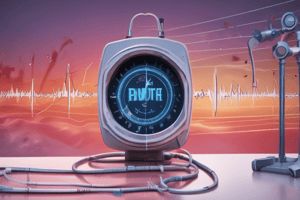Podcast
Questions and Answers
What is the SI unit of pressure?
What is the SI unit of pressure?
- Pascal (Pa) (correct)
- Newton (N)
- Watt (W)
- Joule (J)
In fluid mechanics, which of the following is considered a fundamental quantity of motion along with pressure?
In fluid mechanics, which of the following is considered a fundamental quantity of motion along with pressure?
- Volume
- Mass (correct)
- Density
- Heat
What is the mathematical representation of pressure when defined as force per unit area?
What is the mathematical representation of pressure when defined as force per unit area?
- $P = F / A$ (correct)
- $P = A / F$
- $P = F - A$
- $P = A \times F$
Which type of pressure is referenced to a perfect vacuum as zero and increases positively above atmospheric pressure?
Which type of pressure is referenced to a perfect vacuum as zero and increases positively above atmospheric pressure?
How many main types of pressure are mentioned in the text?
How many main types of pressure are mentioned in the text?
What is the formula for calculating absolute pressure?
What is the formula for calculating absolute pressure?
In gauge pressure, what does a reading of 50 psi indicate?
In gauge pressure, what does a reading of 50 psi indicate?
How is differential pressure calculated?
How is differential pressure calculated?
In physics, why is studying pressure in hydrology important?
In physics, why is studying pressure in hydrology important?
Which scientific discipline heavily relies on high-pressure conditions for chemical synthesis?
Which scientific discipline heavily relies on high-pressure conditions for chemical synthesis?
Flashcards are hidden until you start studying
Study Notes
Pressure is defined as force per unit area. It is a scalar quantity with units of Pascal (Pa) or N/cm² when considering the force applied on an object. In fluid mechanics, pressure is listed among fundamental quantities of motion, along with mass, length, time, temperature, angle, velocity vector, acceleration vector, angular acceleration, energy, power, work, and force. A pressure differential between two points causes a net force acting on an object's surface in the direction of decreasing pressure.
Pressure plays a crucial role in various fields such as mechanical engineering, chemical processes, gas dynamics, and fluid flow among others. In this article, we will explore key concepts related to pressure in physics including its definition, measurement, and applications.
Definition and Measurement of Pressure
Pressure is the amount of force being exerted by a fluid per unit area against which an object is resting. Mathematically, it can be represented as:
P = F / A
where P represents pressure, F denotes the applied force, and A stands for the area over which the force acts.
The International System of Units (SI) defines the standard atmosphere (atm) as a reference value for measuring atmospheric pressure and other types of pressures. One standard atmosphere is equal to approximately 101.3 kPa (kilopascals).
Types of Pressure
There are three main types of pressure: absolute, gauge, and differential.
Absolute Pressure
Absolute pressure is measured from a perfect vacuum, where there are no molecules present and pressure is considered zero. Its formula can be expressed as follows:
P_abs = P - P_vacuum
where P_abs denotes absolute pressure, P signifies actual pressure, and P_vacuum indicates atmospheric or ambient pressure.
Gauge Pressure
Gauge pressure measures the difference between the absolute pressure and atmospheric pressure. This type of pressure is commonly used in hydraulic systems and tire monitoring. For example, if the measurement shows 50 psi (pounds per square inch), that means the actual pressure is 50 pounds higher than atmospheric pressure.
Differential Pressure
Differential pressure is calculated by subtracting one pressure reading from another. It is often used to measure flow rates through pipes and valves.
Applications of Pressure in Physics
In the field of physics, pressure has numerous applications. Some of these include:
- Hydrology: Studying the pressure created by water on structures like dams and bridges is essential to ensure their structural integrity.
- Geology: Exploring geological formations involves understanding the extreme forces exerted upon them due to changes in pressure.
- Meteorology: Atmospheric pressure influences weather patterns and predictive models.
- Fluid Mechanics: Understanding fluids under high pressure helps design efficient machines and optimize processes.
- Chemical Engineering: High-pressure conditions are critical for synthesizing chemicals and materials through heat and chemical reactions.
As pressure is closely related to force and motion, mastering its understanding opens up opportunities across different scientific disciplines.
Studying That Suits You
Use AI to generate personalized quizzes and flashcards to suit your learning preferences.




